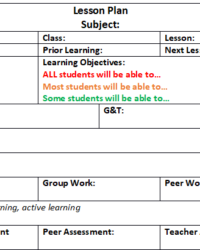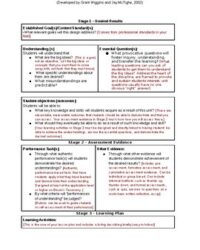Ever found yourself looking for a way to ignite curiosity and problem-solving skills in your students, whether they are in elementary school or a university lecture hall? Design thinking offers a powerful framework for tackling challenges, fostering creativity, and developing empathy. It is an iterative process that encourages users to understand the problem, challenge assumptions, and create innovative solutions. But translating this dynamic methodology into structured, engaging lessons can sometimes feel like a puzzle in itself.
That is where a well-crafted design thinking lesson plan template becomes an invaluable tool. It is more than just an outline; it is a roadmap that guides both you and your students through the various stages of the design thinking process, ensuring that no crucial step is missed while still allowing for the organic, often messy, nature of creative exploration. Using such a template can streamline your preparation, clarify learning objectives, and ultimately enhance the student experience by providing a clear, engaging pathway to innovation.
Why a Design Thinking Lesson Plan Template is Essential for Educators
Imagine walking into a classroom knowing exactly how to guide your students from identifying a real-world problem to prototyping a solution, all while keeping them engaged and excited. A robust design thinking lesson plan template provides that clarity and confidence. It helps you break down complex concepts into manageable steps, making the abstract notion of “innovation” tangible for learners of all ages. This structure is not about rigid adherence but about offering a flexible backbone upon which you can build truly transformative learning experiences. It ensures that every session contributes meaningfully to the overall design challenge, building skills incrementally.
One of the biggest advantages of using a template is consistency. When you have a standardized framework, it is easier to replicate successful lessons, adapt them for different age groups or subjects, and even share them with colleagues. This consistency also benefits students, as they become familiar with the iterative nature of design thinking, understanding that failure is simply an opportunity to learn and refine. The template acts as a visual and procedural anchor, helping students navigate through phases like Empathize, Define, Ideate, Prototype, and Test, ensuring they internalize the process rather than just completing a task.
Furthermore, a template encourages you to think holistically about the learning experience. It prompts you to consider not just the activities, but also the learning objectives, necessary materials, assessment strategies, and reflection points. This foresight is crucial for managing classroom time effectively and maximizing student engagement. Without a template, it is easy to get lost in the exciting world of ideation and forget about crucial steps like testing or iterating, which are vital for a complete design thinking cycle. It helps in allocating appropriate time to each phase, preventing common pitfalls where one phase overshadows others.
Ultimately, a good design thinking lesson plan template empowers you to be a more effective facilitator of learning. It moves you away from being a mere dispenser of information and transforms you into a guide who helps students discover solutions for themselves. This shift is powerful, fostering self-reliance, critical thinking, and a deep understanding of problem-solving that extends far beyond the classroom walls. It means less time planning from scratch and more time engaging with your students’ innovative ideas.
Key Components of an Effective Template
When you are looking at or building a template, several elements are absolutely essential for its effectiveness. These components ensure that the lesson is comprehensive and easy to follow.
- Lesson Title and Objectives: Clearly state what students will learn and be able to do by the end of the lesson.
- Target Audience and Time Allocation: Who is this for, and how long will each phase take?
- Materials and Resources: List everything needed, from sticky notes to digital tools.
- Phased Activities: Detail the specific steps for each design thinking phase (Empathize, Define, Ideate, Prototype, Test). Include guiding questions and activities.
- Assessment and Reflection: How will learning be measured, and how will students reflect on their process and outcomes?
- Differentiation Strategies: How can you support diverse learners or extend the challenge for advanced students?
Crafting Engaging Activities for Each Phase
Each phase of design thinking requires different types of activities to truly engage students. For the Empathize phase, consider interviews, observation exercises, or persona development. In Define, focus on synthesizing research into a clear problem statement. Ideation should be a free-flowing brainstorming session, while Prototyping can involve anything from sketching to building physical models. Finally, the Test phase is crucial for gathering feedback and iterating on solutions. A robust template will prompt you to think about these varied activities and how they flow together.
Putting Your Design Thinking Lesson Plan Template into Action
Once you have your design thinking lesson plan template in hand, the real magic begins: bringing it to life in the classroom. It is one thing to have a structured plan on paper, but quite another to facilitate a dynamic, student-led process. Remember that the template is your guide, not a rigid script. Be prepared to be flexible, allowing student inquiries and discoveries to sometimes lead the way. Embrace the idea that design thinking is an iterative loop, meaning that students might need to cycle back to an earlier phase based on new insights or feedback. This adaptability is key to fostering true innovation and a resilient mindset.
Start small, especially if you or your students are new to design thinking. Perhaps introduce one phase at a time over several lessons before attempting a full cycle. Provide plenty of examples and real-world case studies to inspire and ground their understanding. Encourage collaboration and open communication throughout the process, as design thinking thrives on diverse perspectives. Create a safe space for experimentation and even failure, emphasizing that mistakes are valuable learning opportunities rather than setbacks. Celebrating small wins and acknowledging effort, regardless of the outcome, will build confidence and encourage deeper engagement.
Think of your role as a facilitator and coach, rather than a lecturer. Your job is to ask provocative questions, provide timely feedback, and offer resources when needed, empowering students to take ownership of their learning journey. The template helps you stay organized, but your presence and guidance are what truly bring the design thinking experience to life. It is about fostering an environment where curiosity flourishes, problems are seen as opportunities, and creative solutions emerge organically from the collective efforts of your students.
- Be Flexible: Allow for unexpected discoveries and detours.
- Emphasize Collaboration: Design thinking is a team sport; encourage group work and diverse perspectives.
- Provide Real-World Context: Connect design challenges to issues students care about.
- Celebrate Iteration: Highlight that going back and refining ideas is a strength, not a weakness.
- Focus on the Process: While the outcome is important, the learning that happens during the process is paramount.
Implementing design thinking in your curriculum is more than just teaching a new methodology; it is about cultivating a mindset. It is about equipping students with the tools to approach complex problems with empathy, creativity, and a persistent drive to find meaningful solutions. By leveraging a structured approach, you can effectively introduce and nurture these essential 21st-century skills, preparing your students not just for academic success, but for real-world impact.
Embracing this innovative approach to learning will not only make your lessons more dynamic and engaging but will also empower your students to become active creators and problem-solvers in their communities and beyond. The lasting impact of fostering this kind of thinking will extend far beyond any single project, shaping their abilities to navigate an ever-changing world with confidence and ingenuity.


